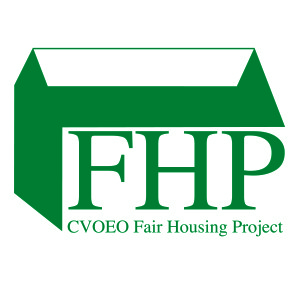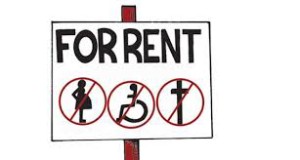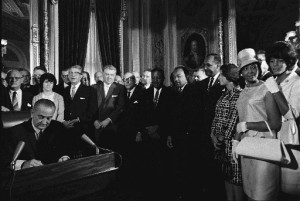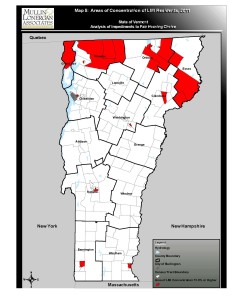Here’s the statement Ted Wimpey provided today to the Vermont Advisory Committee to the U.S. Commission on Civil Rights at a hearing in Montpelier on “Housing Issues”:
For nearly two decades, the Fair Housing Project of the Champlain Valley Office of Economic Opportunity has worked on a variety projects aimed at eliminating or mitigating various aspects of illegal housing discrimination in Vermont. We have been involved, with Vermont Legal Aid as partners, in business practices fair housing audit testing, we have organized programs to educate housing consumers about their fair housing rights; conducted fair-housing trainings for landlords, realtors, municipal and state officials and the general public; received vetted and referred complaints regarding perceived fair housing violations; monitored real estate ads for fair housing violations; and published and distributed fair housing guidebooks in English and more than a dozen other languages.

While continuing to perform many of these functions, the Fair Housing Project has been focusing increasingly on addressing systemic barriers to fair housing choice which can take forms such as excessively restrictive or exclusionary planning, zoning or development policies. With funding from the US Department of HUD, we have in collaboration with a number of organizational partners, mounted a statewide campaign to promote inclusive and affordable development patterns – a campaign called “Thriving Communities: Building a Vibrant, Inclusive Vermont.” This campaign dovetails with a reinvigorated commitment by HUD to better “affirmatively further fair housing” (AFFH), such “affirmatively furthering…” is a mandate of the Federal Fair Housing Act of 1968 that for action purposes has been ill-defined and erratically observed. Just this summer HUD issued a much-anticipated AFFH rule that brings more clarity at least to the process of evaluating whether entities are effectively attempting to conduct programs and policies aimed at AFFH. We will not now dwell on details of the HUD AFFH rule, which has received a fair amount of popular attention and which essentially sets forth a new planning process for federal funding grantees. Suffice it to say here that the thrust of this initiative is to break down historic concentrations of poverty, and racial and ethnic segregation while proactively encouraging integrated development patterns that includes affordable housing in mixed income, higher-opportunity communities.
Residential racial segregation in U.S., while somewhat diminished – at least in some cities- since passage of the Federal Fair Housing Act 47 years ago, remains pervasive, and income segregation has become even more pronounced. Vermont is about 95 percent white, however, and while pockets of minority concentration exist (77 were identified in the state’s last Analysis of Impediments to Fair Housing Choice (AI) – 2012”). Vermont had no census tracts in 2010 where blacks exceeded 7 percent of the population. (Other minorities registered well below 5 percent in most tracts.)
So, while residential segregation by race does bear watching in Vermont – particularly with a significantly increasing number of refugees, immigrants of color, and African Americans typically from more urban areas of the country – it does not exist on the same scale as in many major metropolitan areas. Based on Dissimilarity Index Rankings, the 2012 analysis concluded that Vermont is “moderately segregated for Asians and Blacks and has low degrees of segregation for other minority groups.” It’s also worth noting that minorities in Vermont have lower median incomes and lower rates of home ownership, and that, based on testing results from Vermont Legal Aid’s studies, minorities face higher incidences of housing discrimination than the state’s formal complaint statistics might suggest.
In our Thriving Communities campaign, we’re advocating for broad-based residential inclusiveness – not just for ethnic minorities, but for all protected classes, which in Vermont include people receiving public assistance and which prohibits planning, zoning and permitting processes and decisions that are based on the income level of prospective residents.
In terms of policy and state law, Vermont has taken some positive steps against socioeconomic segregation. (Because of a disparate impact on a number of protected classes under federal and state fair housing law, socioeconomic exclusion effectively equals fair housing law violation especially as regards AFFH obligations.) “Receipt of public assistance” is a protected class under the state’s fair housing law. And Vermont’s law as of 2012 also makes it illegal to discriminate on the basis of income in permitting housing or in making land-use decisions. Also under Vermont’s laws defining parameters for municipal planning and zoning, municipal plans must include “a recommended program for addressing low and moderate income persons’ housing needs.” Moreover, bylaws may not exclude housing that meets the needs of low or moderate income people, and multi-family housing or mobile home parks in particular.
But while the state potentially wields at least a small legal stick, for prohibiting income-exclusiveness, many local jurisdictions have a long way to go in providing carrots for more affordable-housing development and, in collaboration with fair and affordable housing advocates and developers, the state and its fair and affordable housing partners needs to keep educating, encouraging and, if necessary cajoling municipalities into more inclusive housing development policies.
Inclusionary zoning, for example, is becoming an increasingly used tool across the country to add to the affordable housing stock in mixed-income neighborhoods – but it is not yet at all common in Vermont. Inclusionary zoning requires or encourages a certain percentage of affordable units in new housing developments. As far as we know, only Burlington and a small hand full of other towns to lesser degrees, have adopted inclusionary zoning bylaws. We’d like to encourage other Vermont municipalities to give this approach serious consideration.
Other signs of municipal commitment to affordable housing development – density bonuses, or waivers/reductions of impact or permitting fees – are also rare exceptions in Vermont. Several years ago, in reviews of land-use regulations in Chittenden and Lamoille counties, the Fair Housing Project found that many towns still had predominantly large minimum lot sizes and that multifamily housing in many cases was a conditional, rather than a permitted use.
What we’d like to see is more Vermont municipalities’ taking steps to encourage multifamily housing developments near town centers, on sites with ready access to good services, schools and transit. In far too many Vermont towns, as is the case across much of the country, lower-wage workers cannot afford to live near their places of employment. Indeed, a recent review of Vermont’s larger employment centers shows that some are woefully short of subsidized housing.
Granted, the limited availability of public funding and tax credits is a constraint on affordable-housing development. Municipalities nevertheless would do well to prepare the ground for development opportunities as they arise. Vermont’s population deserves no less. More than half Vermont’s renters pay more than 30 percent of their income on housing, and more than one-quarter pays more than 50 percent. Employers feel this burden in another way, when housing costs impede recruitment of workers.
An inclusive community, home to people of a wide range of incomes, backgrounds and skills, embraces fair housing opportunity. We believe this ideal is in keeping with Vermont’s communal character as embodied in its town meeting tradition. Thank you again to the Vermont Advisory Committee for the opportunity to address you on our hopes, fears and concerns regarding fair housing in Vermont.








